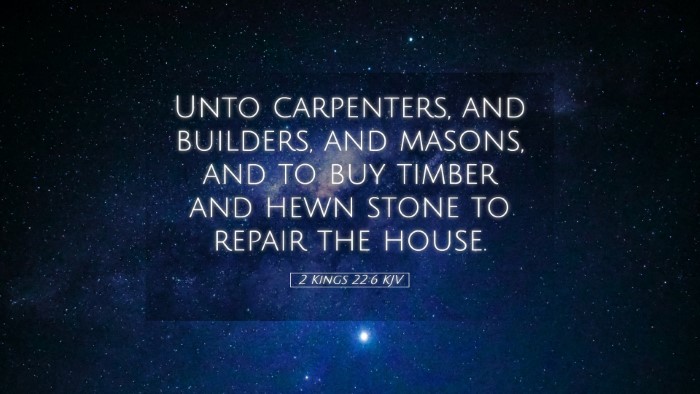Old Testament
Genesis Exodus Leviticus Numbers Deuteronomy Joshua Judges Ruth 1 Samuel 2 Samuel 1 Kings 2 Kings 1 Chronicles 2 Chronicles Ezra Nehemiah Esther Job Psalms Proverbs Ecclesiastes Song of Solomon Isaiah Jeremiah Lamentations Ezekiel Daniel Hosea Joel Amos Obadiah Jonah Micah Nahum Habakkuk Zephaniah Haggai Zechariah Malachi2 Kings 22:6
2 Kings 22:6 KJV
Unto carpenters, and builders, and masons, and to buy timber and hewn stone to repair the house.
2 Kings 22:6 Bible Commentary
Commentary on 2 Kings 22:6
Verse Reference: 2 Kings 22:6 (KJV) - "Unto the carpenters, and builders, and masons, and to buy timber and hewn stone to repair the house."
Introduction
The verse 2 Kings 22:6 occurs within the context of King Josiah's reforms in Judah. After the discovery of the Book of the Law during the repair of the temple, Josiah initiated extensive religious reforms. This verse focuses on the practical measures taken to repair the temple, symbolizing a restoration of proper worship and a commitment to God’s service.
Historical Context
Josiah became king at the tender age of eight and ruled for thirty-one years. His reign is noted for a return to the worship of Yahweh, contrasting sharply with the idolatrous practices that had previously dominated Judah. The historical backdrop to this verse includes the neglect of the temple, which had fallen into disrepair due to the corrupt practices of previous kings.
- Josiah’s Early Reign: Josiah began to seek the God of his father David at age sixteen, indicating his piety and desire for reform.
- The Discovery of the Law: The discovery of the Book of the Law in the temple catalyzed his reforms, leading to a national turning back to God.
- The Importance of the Temple: The temple was central to Jewish worship and identity; its restoration signified a return to covenant faithfulness.
Exegesis of Key Terms
In this verse, the words "carpenters," "builders," and "masons" are significant. Each term carries connotations of skill and craftsmanship, emphasizing the communal effort required to restore the temple.
- Carpenters: Those who worked with wood, vital in repairing the structure and making it functional once again.
- Builders: Representing a broader workforce invested in renewing the spiritual heart of the nation.
- Masons: Skilled workers who would ensure that the foundational structure of the temple remained strong and resilient.
Spiritual Significance
The rebuilding of the temple serves as a metaphor for the spiritual renewal that occurs in the lives of individuals and communities. The act of repairing the temple reflects not only physical restoration but also a deeper need for spiritual revival.
- Symbolism of Restoration: Just as the temple was repaired, believers are called to restore their lives and communities through repentance and faith.
- Community Involvement: The diverse group of workers indicates that spiritual renewal is a collective endeavor, requiring the participation of all members of the faith community.
- The Role of Leadership: Josiah's commitment to repairing the temple highlights the importance of godly leadership in facilitating spiritual awakening.
Insights from Public Domain Commentaries
Matthew Henry
Matthew Henry emphasizes that this repair work signifies a returning to God’s ordinances. Henry notes that the neglect of the temple represents the neglect of God's service. He underlines that the materials used for the repair—timber and hewn stone—symbolize the need for durability and strength in our spiritual foundations. Just as the physical edifice of the temple needed restoration, so too does the heart of man require continuous maintenance through the word of God and community support.
Albert Barnes
Albert Barnes underscores that the directive to engage skilled workers reflects a wise and methodical approach to restoration. He portrays this as reflective of God’s orderliness, as seen throughout creation. The involvement of builders and masons signifies that rebuilding the spiritual life requires diligent work and attention to detail, mirroring the care one should take in cultivating a relationship with God. Barnes often remarks on the cooperative nature of such undertakings, suggesting that spiritual work must be shared among the faithful.
Adam Clarke
Adam Clarke reflects on the practical applications of this verse, highlighting that the temple's repair was vital for the nation's restoration. He sees in Josiah's actions a precursor to the later New Testament understanding of the church as the body of Christ. Clarke posits that every believer must see themselves as a part of this spiritual construction, equipped to contribute using their unique gifts for the edification of the church. His commentary invites readers to assess their roles in God's work and participate actively in the restoration of worship in their contexts.
Conclusion
The essence of 2 Kings 22:6 lies not solely in its historical and physical restoration narrative but also in the rich spiritual lessons it conveys. As pastors, students, and scholars reflect on this passage, they are encouraged to consider the state of their "temples." Are we actively participating in the work of restoration in our communities and personal lives? Just as Josiah initiated the repair of the temple, modern believers are called to renew their commitment to God through practical actions and collective engagement in spiritual practices.
The involvement of craftsmen can be viewed as a call for a collaborative effort in spiritual growth—inviting the skills and resources of various members to strengthen and repair the community of faith. Each believer, equipped with distinct gifts and talents, contributes to the larger mission of reflecting God's glory and presence in the world.


